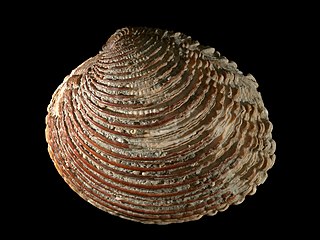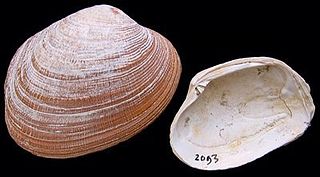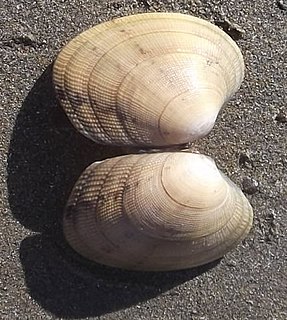
Clam is a common name for several kinds of bivalve molluscs. The word is often applied only to those that are edible and live as infauna, spending most of their lives halfway buried in the sand of the seafloor or riverbeds. Clams have two shells of equal size connected by two adductor muscles and have a powerful burrowing foot. They live in both freshwater and marine environments; in salt water they prefer to burrow down into the mud and the turbidity of the water required varies with species and location; the greatest diversity of these is in North America.

Noise pollution, also known as environmental noise or sound pollution, is the propagation of noise with ranging impacts on the activity of human or animal life, most of them harmful to a degree. The source of outdoor noise worldwide is mainly caused by machines, transport, and propagation systems. Poor urban planning may give rise to noise disintegration or pollution, side-by-side industrial and residential buildings can result in noise pollution in the residential areas. Some of the main sources of noise in residential areas include loud music, transportation, lawn care maintenance, construction, electrical generators, explosions, and people.

Bivalvia, in previous centuries referred to as the Lamellibranchiata and Pelecypoda, is a class of marine and freshwater molluscs that have laterally compressed bodies enclosed by a shell consisting of two hinged parts. Bivalves as a group have no head and they lack some usual molluscan organs like the radula and the odontophore. They include the clams, oysters, cockles, mussels, scallops, and numerous other families that live in saltwater, as well as a number of families that live in freshwater. The majority are filter feeders. The gills have evolved into ctenidia, specialised organs for feeding and breathing. Most bivalves bury themselves in sediment where they are relatively safe from predation. Others lie on the sea floor or attach themselves to rocks or other hard surfaces. Some bivalves, such as the scallops and file shells, can swim. The shipworms bore into wood, clay, or stone and live inside these substances.
Perkinsus is a genus of alveolates in the phylum Perkinsozoa. The genus was erected in 1978 to better treat its type species, Perkinsus marinus, known formerly as Dermocystidium marinum. These are parasitic protozoans that infect molluscs, at least some of which cause disease and mass mortality. P. marinus is the most notorious, causing the disease perkinsosis, or dermo, in wild and farmed oysters.

The Veneridae or venerids, common name: venus clams, are a very large family of minute to large, saltwater clams, marine bivalve molluscs. Over 500 living species of venerid bivalves are known, most of which are edible, and many of which are exploited as food sources.

Venerupis philippinarum is an edible species of saltwater clam in the family Veneridae, the Venus clams.

Fishing is a major economic activity in Portugal. The country has a long tradition in the sector, and is among the countries in the world with the highest fish consumption per capita. Roman ruins of fish processing facilities were found across the Portuguese coast. Fish has been an important staple for the entire Portuguese population, at least since the Portuguese Age of Discovery.

The grooved carpet shell, or Palourde clam, Ruditapes decussatus, or Venerupis decussatus, is a clam in the family Veneridae. It is distributed worldwide and due to its ecological and economic interest has been proposed as a bioindicator.

Ruditapes largillierti is a saltwater clam, a marine bivalve mollusc in the family Veneridae, the Venus clams. They are moderately large for their genus, elongate and subrectangular, thick and solid, with smooth ventral margin.
Marteilia is a protozoan genus of organisms that are parasites of bivalves. It causes QX disease in Sydney rock oysters and Aber disease in European flat oysters. After being infected by Marteilia, bivalves lose pigmentation in their visceral tissue and become emaciated.

Aliivibrio is a genus in the phylum Proteobacteria (Bacteria).

South Korea occupies the southern portion of the Korean peninsula. The total land mass of the country is 98,480 km2 but usable land is only 20% of the total and thus the population is concentrated around the coast. The Korean Peninsula is surrounded by the East, West and South Seas, a coast-line that extends for about 2,413 km. Endowed with an abundance of fisheries resources, Koreans have developed a distinct seafood culture with annual per capita sea food consumption of 48.1 kg in 2005.

Venerupis decussata is a marine bivalve mollusc in the family Veneridae, commonly known as the cross-cut carpet shell.

Venerupis corrugata, the pullet carpet shell, is a species of bivalve mollusc in the family Veneridae. It is found buried in the sediment on the sea bed in shallow parts of the eastern Atlantic Ocean. It is harvested for human consumption in Spain and other parts of Western Europe.
Vibrio tapetis is a Gram-negative, rod-shaped bacterium, the causative agent of the brown ring disease that affects cultured clams. B1090 is the type strain.

Arcuatula senhousia, commonly known as the Asian date mussel, Asian mussel or bag mussel, is a small saltwater mussel, a marine bivalve mollusk species in the family Mytilidae, the mussels. Other common names for this species include: the Japanese mussel, Senhouse's mussel, the green mussel, and the green bagmussel. It is harvested for human consumption in China.
Acanthoparyphium tyosenense is a species of digenetic trematodes in the family Himasthlidae.
Marinomonas atlantica is a bacterium from the genus of Marinomonas which has been isolated from clams Ruditapes decussatus.
Mytilicola orentalis is an intestinal copepod parasite of bivalves with a direct life cycle. It is native to the waters around Japan and was introduced to Europe in the 1960s and 70's with oyster imports. Host species include the blue mussels, the pacific oyster, and Ruditapes philippinarum.














